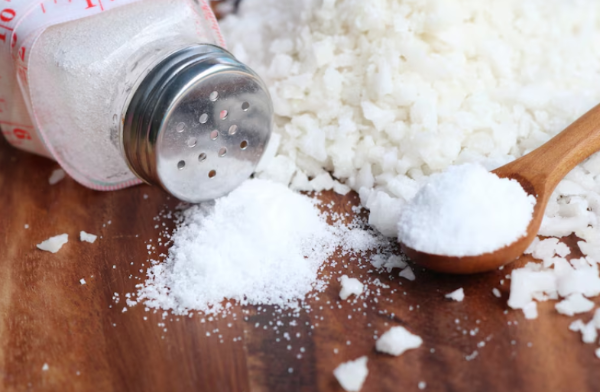Epsom Salt for Toenail Fungus
Epsom Salt for Toenail Fungus: A Natural Remedy Worth Considering

Toenail fungus, scientifically known as onychomycosis, is a condition that affects millions of people worldwide. It can lead to discolored, thickened nails that are not only unsightly but may also cause discomfort and even pain.
While a variety of over-the-counter and prescription treatments are available, many people are turning to natural remedies to combat toenail fungus. One such remedy is Epsom salt, a common household product known for its therapeutic benefits.
In this comprehensive guide, we’ll dive deep into how Epsom salt can help treat toenail fungus, its benefits, how to use it, and any precautions you should take when using this remedy.
What is Epsom Salt?
Epsom salt is a naturally occurring mineral compound made up of magnesium sulfate. Despite its name, it is not technically a salt but a mineral compound.
It was first discovered in the 17th century in Epsom, Surrey, England, where it was found in the water of a local spring. For centuries, people have used Epsom salt for various health and wellness purposes, ranging from soothing sore muscles to promoting relaxation.
Epsom salt is rich in magnesium, an essential mineral that plays a vital role in numerous bodily functions, such as regulating muscle and nerve function, blood sugar levels, and the production of protein and bone.
Magnesium sulfate has also been used to treat various conditions, including constipation, inflammation, and even certain skin ailments. The potential benefits of Epsom salt go beyond just internal health; it has also found a place in topical treatments for skin conditions like toenail fungus.
What Causes Toenail Fungus?
Toenail fungus occurs when fungi (often dermatophytes, yeasts, or molds) infect the toenails. The infection can begin in the nail bed, where the fungus thrives in warm, moist environments, such as those found in sweaty shoes, public showers, or swimming pools.
Poor hygiene, a weakened immune system, and conditions like diabetes can also increase the risk of developing toenail fungus.
Symptoms of toenail fungus include:
- Discoloration: The nail may turn white, yellow, or brown.
- Thickening: The nail becomes thicker and more brittle.
- Crumbly Nails: The nail may begin to crumble or break easily.
- Foul Odor: A pungent smell may emanate from the infected area.
- Separation of the Nail: The infected nail may begin to separate from the nail bed.
- Pain: In severe cases, the infection can cause discomfort or pain.
Toenail fungus is often persistent and can be challenging to treat. While antifungal medications, both topical and oral, are common treatments, many people seek alternative or complementary therapies to help combat the infection. Epsom salt is one such remedy.
How Epsom Salt Helps with Toenail Fungus?
Epsom salt is primarily known for its ability to relieve muscle aches and promote relaxation, but it also offers benefits that can help treat toenail fungus.
The two key properties of Epsom salt that make it effective in treating toenail fungus are its magnesium content and its antifungal and anti-inflammatory effects.
Magnesium and Its Role
- Magnesium is an essential mineral for the body and plays a critical role in various bodily functions, including regulating the immune system. A lack of magnesium can impair the body’s ability to fight infections, including fungal infections like toenail fungus. Soaking your feet in Epsom salt may help increase magnesium levels in the body through absorption via the skin. This can help improve overall immune function, which in turn supports the body’s ability to fight off fungal infections.
Antifungal Properties
- Epsom salt has natural antifungal properties, which makes it a helpful adjunct treatment for toenail fungus. Magnesium sulfate has been found to disrupt the cell wall of certain fungi, preventing them from growing and spreading. By creating an environment that is less hospitable to fungi, Epsom salt may help reduce the infection and promote healing.
Anti-inflammatory Effects
- Magnesium also has anti-inflammatory properties, which can be beneficial for treating toenail fungus. The inflammation caused by the infection can cause pain, swelling, and discomfort. Soaking your feet in Epsom salt may help reduce this inflammation, providing relief from these symptoms and promoting faster healing of the affected area.
Soothing and Cleansing
- Epsom salt can help soothe irritated skin and soften the toenail, which may allow better penetration of other antifungal treatments. Additionally, it helps cleanse the toenail and surrounding skin, removing debris that may contribute to the fungal growth. This can create an environment more conducive to healing.

Benefits of Using Epsom Salt for Toenail Fungus
Affordable and Accessible
- Epsom salt is a cost-effective treatment that is easily accessible. You can find it at most drugstores, supermarkets, and even online. It’s inexpensive compared to other antifungal treatments, making it an attractive option for people looking for a budget-friendly alternative.
Natural Remedy
- Many people are turning to natural remedies to avoid the side effects associated with pharmaceutical treatments. Epsom salt is a natural product with few known side effects when used properly, making it an appealing option for individuals looking for an all-natural way to treat toenail fungus.
Minimal Risk of Side Effects
- Unlike oral antifungal medications, which can come with side effects such as digestive issues or liver damage, Epsom salt is used topically and absorbed through the skin, limiting the risk of systemic side effects. This makes it a safer alternative for individuals with underlying health conditions or those who are sensitive to medications.
Easy to Use
- Using Epsom salt to treat toenail fungus is simple and requires no specialized equipment. A foot soak in warm water mixed with Epsom salt can be done in the comfort of your home, making it an easy addition to your self-care routine.
Soothing and Relaxing
- One of the most enjoyable benefits of using Epsom salt is its calming effect. Foot soaks are known to relieve stress and promote relaxation. By incorporating Epsom salt into your toenail fungus treatment, you can enjoy the added benefit of soothing your body and mind.
How to Use Epsom Salt for Toenail Fungus?
To get the most out of Epsom salt for toenail fungus, follow these simple instructions for a foot soak:
Prepare the Foot Soak
- Fill a basin or tub with warm water. The water should be deep enough to fully submerge your feet. Add about 1/2 to 1 cup of Epsom salt to the water. Stir it well to ensure that the salt dissolves completely.
Soak Your Feet:
- Place your feet in the warm water and let them soak for about 20 to 30 minutes. During this time, the Epsom salt will help to soften the toenails and cleanse the area, while the magnesium can be absorbed through the skin.
Dry Your Feet Thoroughly:
- After soaking, remove your feet from the water and dry them thoroughly with a clean towel. Make sure to dry the space between your toes, as moisture can encourage further fungal growth.
Repeat the Soak:
- For the best results, it is recommended to soak your feet in Epsom salt water daily, especially in the early stages of the fungal infection. This will help promote healing and reduce the spread of the fungus.
Combine with Other Treatments:
- While Epsom salt can help manage toenail fungus, it is often most effective when used alongside other antifungal treatments. After soaking, you can apply an over-the-counter antifungal cream or oil to the affected area. Natural oils such as tea tree oil or coconut oil are commonly used to treat fungal infections and can be a good addition to your regimen.
Precautions and Considerations
- Staining: While Epsom salt is generally harmless, be aware that some individuals may experience staining on their toenails or the surrounding skin. This is more likely if you use it in conjunction with other topical treatments, so be cautious when applying and avoid staining clothing or linens.
- Overuse: While Epsom salt is a safe and natural remedy, it’s important not to overuse it. Excessive soaking can lead to dry skin, so be sure to moisturize your feet after each soak to prevent dryness and cracking.
- Consult a Doctor: If the toenail fungus doesn’t improve after using Epsom salt, or if it worsens, consult a healthcare provider. Severe cases of toenail fungus may require prescription-strength antifungal medications. Additionally, people with compromised immune systems, diabetes, or other health conditions should check with a doctor before trying home remedies.
- Avoid Open Cuts: Do not use Epsom salt soaks if you have open cuts or wounds on your feet. The salt could irritate the skin and cause discomfort. Always ensure that the affected area is intact before applying any treatments.
Conclusion
In conclusion, Epsom salt offers a simple, natural, and cost-effective approach to managing toenail fungus.
Its magnesium content, combined with its antifungal and anti-inflammatory properties, can help create an environment that promotes healing while soothing the discomfort associated with the infection.
Regular foot soaks can support overall nail health and potentially reduce the severity of fungal growth. Epsom salt is a safe, effective, and natural remedy for treating toenail fungus.
While it may not completely replace prescription medications for more severe cases, Epsom salt can be an excellent complementary treatment, especially when used in combination with other antifungal therapies.
While Epsom salt can be a helpful adjunct in treating toenail fungus, it’s important to remember that it may not be a cure-all, particularly for more severe infections.
For best results, it’s advisable to combine Epsom salt treatments with other antifungal methods and maintain proper foot hygiene. By taking a balanced, patient approach to treatment, Epsom salt can be a valuable tool in your journey to healthier, fungus-free nails.

.